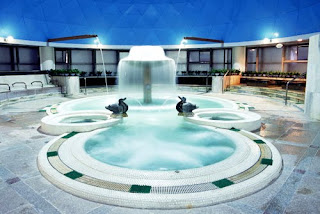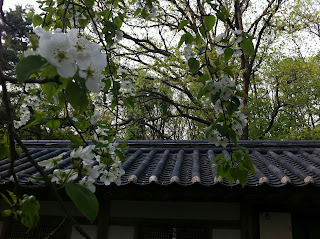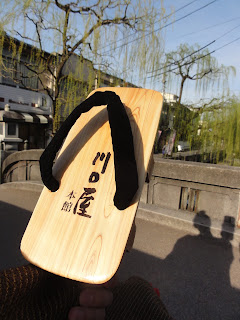Prior to going to South Korea, our knowledge of Korea was limited to Korean BBQ, Korean hot pots, their text using circles, and a Korean spa that Anthony went to once. So we were both excited to go to South Korea and learn a little more about their culture.
Korean Kindness
Taking a high-speed ferry from Fukuoka, Japan, we arrive at Busan, South Korea's 2nd largest city behind Seoul. Trying to find our hotel, we were looking at one of those area maps inside the subway station. A Korean guy passes us by and stops, asking us if we need any help. I have the hotel name, address, and phone number written down in Korean, so I hand it over to him. He whips out his phone and calls the hotel for directions. He then tells us that we went one stop too far and suggest that we take a cab since trying to walk there might be difficult since we don't know the language. We walk out of the subway station w/ the Korean guy and he waves down a cab for us and tells the cabbie where to go. He then waves us good-bye and we thank him. We're in the cab shocked at the helpfulness of this guy. Through all of my travels, I have had numerous people be generous with their time when asked for directions or a little help, but never anything like this. And this was perhaps an hour after arriving in South Korea. Though we never experienced anything like this through the rest of our time in South Korea, we did have a couple of other people ask us if we needed help translating the menu and such. So it was great to have experienced the outgoing and helpful nature of Koreans.
Korean Spa
As mentioned in other posts, we spent a lot of time in Japanese baths, so it was fitting that we experience the Korean bath as well. Our first night in Korea, we head over to the largest Korean bath in Asia, Hurshimchung. Unfortunately, no pictures were taken since you're pretty much walking around the place naked, so I had to grab pictures from around the web. But it was pretty great. The difference between the Japanese and the Korean bath is the number of baths that they had in the Korean spa. They had large baths, baths of varying temperatures, baths w/ varioius minerals in it, cold baths, an outdoor bath, a lap pool, and even a bath where you can sit and order snacks. They also have various temperature wet and dry saunas. There is also a co-ed area called jjimjilbang where you have to put on pajama-like outfits that the spa provides. There you can lie around on the mats, order food, or partake in the more dry saunas of varying temperatures. But since we got to Hurshimchung late, we weren't able to use this part of the sauna. We wanted to go to another one when we went to Seoul, but we just didn't make it out to one.
 |
| The Plaza; Facing the Main Hall |
 |
| The Plaza; Facing the Gate |
 |
| Anthony Listening in on the Very Useful Audio Guide |
Our favorite part of the palace grounds was a pavilion called Gyeonghoeru, which was set in the middle of the lake. The pavilion was used for special banquets. Unfortunately, our pictures did it no justice.
 |
| Gyeonhoeru |
We did manage to catch the changing of the guards in front of Gyeongbokgun. The weird thing was that most, if not all, were wearing fake beards/mustaches. We guess it's to make it more authentic looking. To us, it just looked funny.
Chyeongbokgung Palace
On our last full day in South Korea, we finally got some sunshine and took some beautiful pictures of Cheongbokgun Palace. This palace is considered to be 2nd in historical significance to Gyeongbokgun, but it is actually the one that is the most well preserved and does look far more impressive. This palace was built by the 3rd king of the Joseon Dynasty. It is said that since that king had to kill his half brothers to ascend to the throne, he wanted to live in a difference palace than where his half brothers were slain.
Notice how the underside of the roofs were painted. The adornment is called "Dancheong" and it really did make the structures all the more beautiful
The best part of Cheongbokgun is their garden, which can only be viewed w/ a tour guide and an additional cost. Having missed both english tour guides of the garden, we jumped in a Korean tour since it would allow us to still see the garden. It was quite serene and provided us with some more beautiful structures, so we were glad that we made that decision.
 |
| Darin In Front of the Eosomun Gate and Juhamnu Pavillion |
 |
| Anthony With Their Korean Tour Guide |
Korean Alphabet
On our first evening in South Korea, we quickly realized that we'll have a bit of a language barrier since English wasn't posted on every menu or sign, unlike in Japan. So Anthony decided to start snapping away at picture menus to be able to figure out what food they can order. It turns out that reading Korean can be quite simple. After a week, with a little cheat sheet, Anthony was able to read "kimchi", "mandu" (dumplings), "galbi" (marinated beef dish), "haewool" (seafood), "seoul" (which actually reads su-wol), and a few other words.
It turns out that the 4th king of the Joseon Dynasty, King Sejong the Great, is credited with creating Hangul, the Korean alphabet. Previously, Korea would use Chinese characters in scripts but King Sejong thought that it was too difficult to learn and made it too difficult for commoners to read and therefore, resulted in the commoners not knowing how to properly behave in public. He also felt that the Chinese characters didn't match well to the Korean language. So he had his scholars come up with Hangul. Currently, there are 24 consonants and vowels that make up Hangul and are written in groups to represent a syllable. So to most westerners, it would seem that Koreans use characters representing their language. In fact, each "character" is actually a block of 2-3 (sometime 4) letters grouped together.
It was pretty interesting info that Anthony found out and proved that it indeed is easy to learn to read, which was the goal of King Sejong. Unfortunately, the elites of the time didn't want the commoners to learn to read, since reading is an upper/learned class activity. So it took a couple of centuries until it was widely adopted. But it's used now and it sure is neat.































































